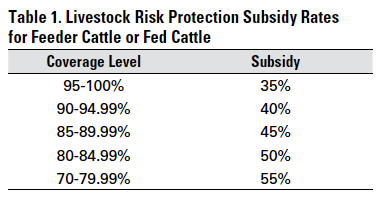Secret Variables to Think About When Finding Animals Danger Defense (LRP) Insurance Coverage
When assessing alternatives for Livestock Threat Security (LRP) insurance coverage, several essential elements warrant cautious consideration to ensure reliable risk monitoring in the farming market. Selecting the best protection options customized to your particular livestock procedure is vital, as is comprehending how premium prices associate with the degree of security provided.
Coverage Options
When thinking about Livestock Risk Security (LRP) insurance, it is important to understand the various coverage options readily available to mitigate threats in the farming industry. Livestock Threat Defense (LRP) insurance policy uses different coverage alternatives customized to satisfy the diverse needs of animals producers.
An additional crucial protection choice is the endorsement duration, which determines the size of time the coverage is in impact. Producers can choose the endorsement period that finest fits their manufacturing cycle and market conditions. In addition, protection degrees and prices differ based on the kind of animals being guaranteed, offering producers the versatility to personalize their insurance coverage intends according to their details needs.
Recognizing the different insurance coverage options offered under Livestock Risk Protection (LRP) insurance policy is crucial for manufacturers to make educated choices that successfully safeguard their livestock procedures from market unpredictabilities.
Premium Costs

Livestock Threat Defense (LRP) insurance policy provides important protection choices customized to alleviate dangers in the farming industry, with a considerable element to consider being the estimation and framework of premium expenses. These consist of the type and number of livestock being insured, the insurance coverage level chosen, the current market costs, historical cost data, and the length of the insurance coverage period.
Insurance companies examine historical information on livestock prices and manufacturing costs to identify an appropriate costs that mirrors the degree of danger involved. It is essential for animals producers to thoroughly evaluate premium expenses and coverage alternatives to ensure they are properly shielded against prospective monetary losses due to adverse market problems or unanticipated occasions.
Eligible Livestock
The resolution of eligible animals for Animals Danger Protection (LRP) insurance protection entails cautious consideration of specific criteria and attributes. Livestock kinds that are typically qualified for LRP insurance coverage include feeder livestock, fed lambs, swine, and livestock.
Feeder livestock, as an example, are frequently eligible for LRP coverage if they drop within defined weight ranges. Fed cattle may likewise be qualified, but they should fulfill specific weight and top quality grade demands. Swine eligible for insurance coverage usually include market weight pets meant for massacre. Lambs are one more group of livestock that can be considered for LRP insurance, with aspects such as weight and age playing a crucial function in determining their qualification.
Before picking LRP insurance for animals, producers need to very carefully review the eligibility standards outlined by the insurance coverage service provider to guarantee their animals fulfill the necessary demands for insurance coverage.
Policy Versatility
Policy flexibility in Livestock Risk Protection (LRP) insurance policy permits manufacturers to customize protection to match their particular requirements and run the risk of management techniques. This flexibility empowers animals producers to tailor their insurance policy policies based on factors such as the kind of livestock they own, market problems, and private risk resistance degrees. By offering personalized choices, LRP insurance coverage enables manufacturers to successfully handle their risk direct exposure while safeguarding their animals operations versus unforeseen market volatility.
Cases Process
Upon experiencing a loss or damage, manufacturers can launch the claims procedure for their Livestock Danger Protection (LRP) insurance coverage by promptly calling their insurance policy supplier. It is crucial for manufacturers to report the loss as soon as feasible to speed up the cases process. When connecting to the insurance supplier, producers will certainly require to provide thorough information regarding the event, consisting of the date, nature of the loss, and any kind of appropriate documents such as veterinary records or market value.

After the assessment is full, the insurance coverage go copyright will certainly make a decision regarding the insurance claim and connect the special info result to the manufacturer. The manufacturer will certainly get settlement according to the terms of their Livestock Threat Protection (LRP) insurance coverage policy if the case is authorized. It is vital for producers to be knowledgeable about the cases procedure to guarantee a smooth experience in the event of a loss

Conclusion
To conclude, when selecting Animals Risk Security (LRP) insurance policy, it is vital to think about insurance coverage options, premium prices, qualified livestock, policy adaptability, and the claims process. These crucial variables will help guarantee that farmers and herdsmans are adequately secured versus prospective dangers and losses linked with their animals operations. Making a notified choice based upon these factors to consider can ultimately result in better financial safety and comfort for animals manufacturers.
Animals Risk Defense (LRP) insurance coverage provides different insurance coverage choices tailored to fulfill the varied needs of livestock manufacturers.The decision of eligible animals for Livestock Risk Defense (LRP) insurance protection includes cautious factor to consider of details requirements and attributes.Policy flexibility in Livestock Risk Protection (LRP) insurance allows producers to customize protection to suit their particular needs and risk management approaches.Upon experiencing a loss or damages, producers can initiate the cases process for their Livestock Threat Defense (LRP) insurance coverage by immediately contacting their insurance service provider.In conclusion, when picking Livestock Risk Defense (LRP) insurance coverage, it is essential to take into consideration coverage alternatives, premium costs, like it qualified livestock, plan flexibility, and the cases process.
 Tia Carrere Then & Now!
Tia Carrere Then & Now! Daniel Stern Then & Now!
Daniel Stern Then & Now! Elin Nordegren Then & Now!
Elin Nordegren Then & Now! Phoebe Cates Then & Now!
Phoebe Cates Then & Now! Daryl Hannah Then & Now!
Daryl Hannah Then & Now!